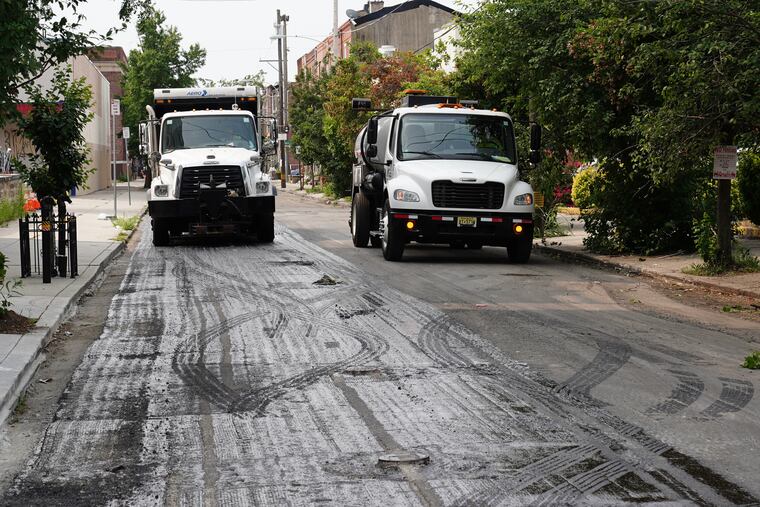Why does street paving in Philly take so long?
It's an annual tradition that likely means weeks of ripped-up roads.

Happy street-paving season to all who celebrate or longingly stare out their car window as they feel every bit of raised asphalt that’s been there for what feels like many, many weeks.
The Streets Department begins its annual roadwork around late March and continues through November. The process per block is broken into four major steps that should run for three to five weeks.
But that doesn’t always happen, and Philly residents like Justin Holden have noticed.
He asked Curious Philly, The Inquirer’s forum for questions about the city and region, why on earth it takes so long.
“I know it’s not apples to apples, but the recent rebuilding of I-95 showed what can be done from an infrastructure perspective when government puts its mind to it,” he said. “Torn-up streets for months on end impacts cyclists, people with disabilities, and probably others that I’m not thinking of.”
Here’s what we know about paving in Philly.
» ASK US: Have something you’re wondering about the Philly region? Submit your Curious Philly question here.
The process
Paving is broken into four steps, broken up between private and city forces, that can take one to two days per step depending on the street’s length and width.
The first step involves grinding inches of the old asphalt surface, a process called milling, which requires specialized trucks and machinery. Step two is all about adjusting manhole covers and resetting utility boxes. Then comes the actual paving where delays can happen.
Take South Philly and a stretch of scattered blocks south of Washington Avenue between Sixth and 10th Streets.
On the Streets Department’s StreetSmartPHL website, the stretch from the 1100 to 1200 blocks of South Sixth Street, the 1100 to 1300 blocks of East Passyunk Avenue, and the 1100 to 1500 blocks of South 10th Street were slated for paving the week of July 17 but weren’t. “No Parking” warnings set for July 17-21 were posted on the Sixth Street blocks. The trucks, however, didn’t show up until last Wednesday.
Other neighborhoods, such as East Mount Airy, have experienced similar timeline changes, according to the Streets Department’s website. That includes East Mount Airy Avenue from Lowber Avenue to Cheltenham Avenue.
The Streets Department said several disruptions can affect scheduled paving, including emergency utility work or special events, but weather, especially heavy rain like the kind that hit the region recently, is a big factor. New, hot asphalt can’t be installed or cure properly when the ground is wet, according to the agency.
Cars that ignore street signage and require removal to clear the way for workers can also delay the paving process.
Once the asphalt is cured, the final step in the process is adding stripes and traffic markings.
How does Philly compare to other cities?
Cities like Baltimore and Phoenix don’t offer specific work estimates on their repavement FAQ sites. Those cities didn’t immediately respond to questions about how long it takes them to resurface streets.
The New York City Department of Transportation says its street-resurfacing projects take “less than a month to complete.” For Chicago, the paving process lasts two or three weeks.
The city even reassures residents that it tries to keep as small of a gap as possible between steps, though that doesn’t always happen.
“Be assured that [Chicago Department of Transportation] has not forgotten about the project,” reads the city’s repaving page when addressing gaps between work stages.
In a statement, the Philly Streets Department said something similar, acknowledging the replacement blitz could be disruptive.
“We appreciate residents’ support and patience as we work to improve city streets,” read the statement.